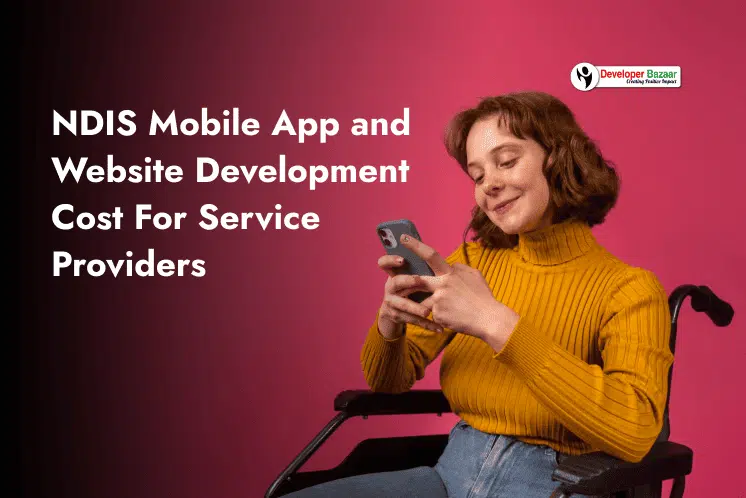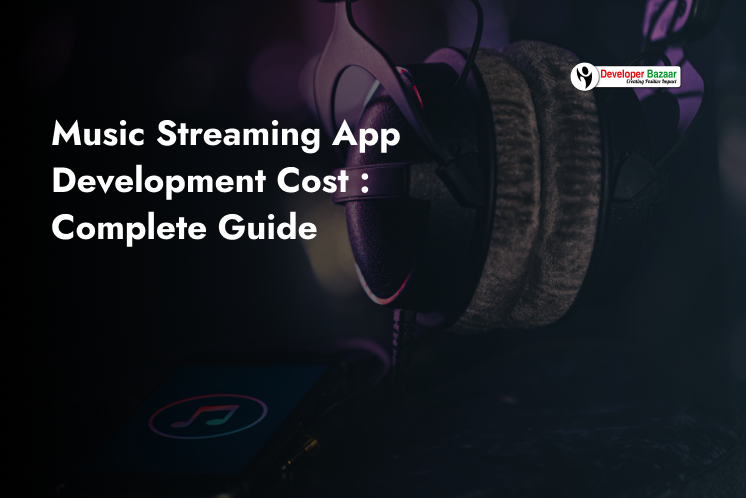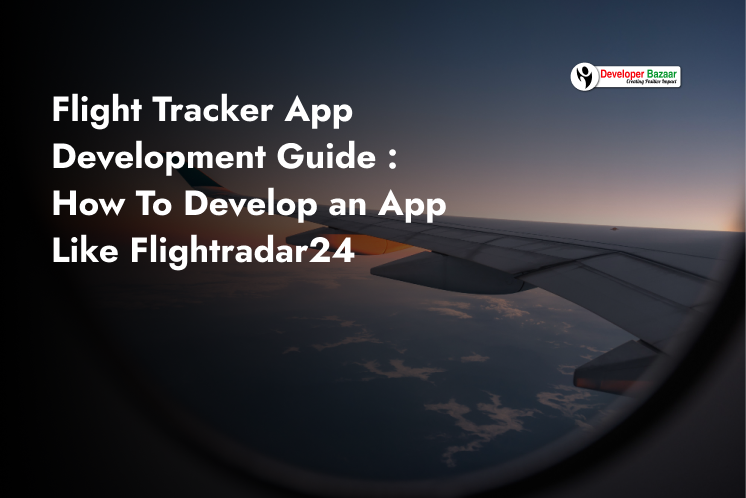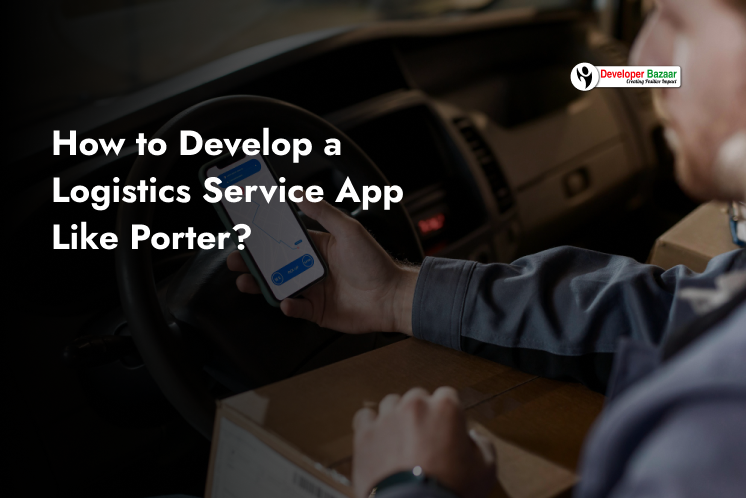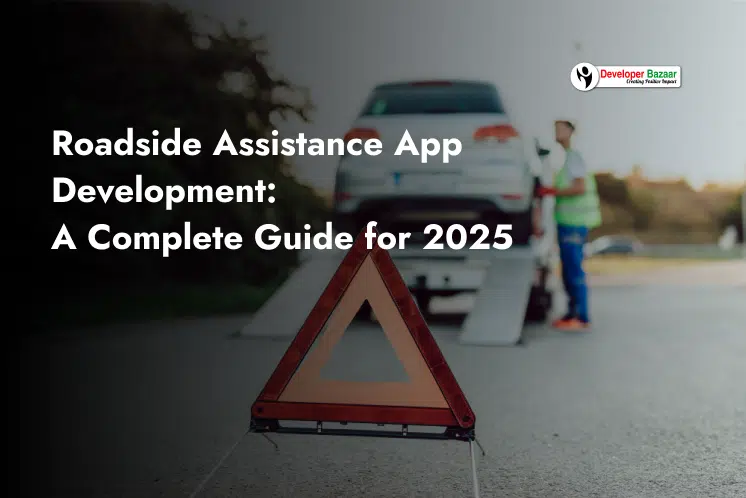Table of Contents
ToggleService providers under the National Disability Insurance Scheme (NDIS) are increasingly turning to technology to transform how they used to support participants earlier. And why not? They got solid reasons for this.
According to IBIS World, the NDIS industry revenue is estimated to grow at an annualised 12.1% over the five years through 2024-25, to $48.7 billion. This exponential growth has attracted many NDIS service providers and convinced them to develop dedicated websites and mobile apps.
These websites and mobile apps for NDIS services not only streamline service delivery but also ensure improved accessibility, transparency, and efficiency. These can benefit service providers in simplifying day-to-day operations, such as appointment booking, staff management, participant progress tracking, and real-time communication.
More importantly, it ensures compliance with accessibility standards, making services easier to use for people with disabilities.
However, one crucial question arises whenever service providers think of developing an app or website, i.e., How much does it cost to build an NDIS mobile app or website?
Let’s discuss the cost of developing an NDIS mobile app and website, along with the factors affecting its total development costs. So, let’s start.
Why NDIS Service Providers Need a Mobile App or Website?
Before moving on to the cost of NDIS mobile app development, let’s first discuss the advantages of building a custom mobile app or website for the NDIS service providers.
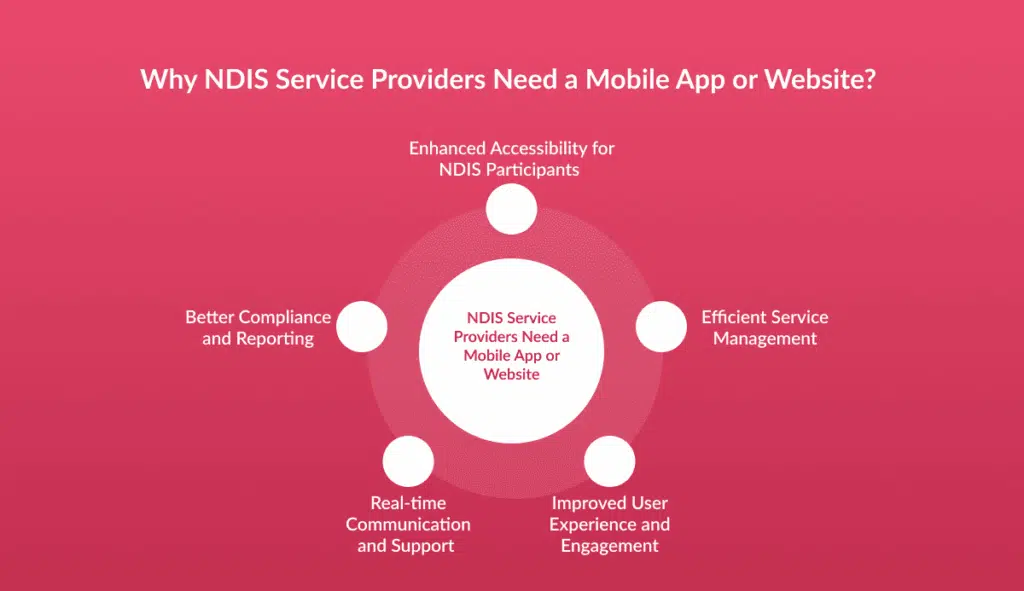
1. Enhanced Accessibility for NDIS Participants
The major advantage of developing a custom NDIS mobile app and website is that it allows participants to easily find, book, and manage NDIS services from the comfort of their homes.
An intuitive and accessible digital platform has user-friendly features like voice commands, screen readers, and high-contrast modes, that help in meeting participants’ accessibility standards, ensuring that individuals with varying abilities can use them with ease.
2. Efficient Service Management
With NDIS mobile app and website development, NDIS service providers can easily manage their staff, schedules, participant profiles, invoices, and more.
A dedicated website and mobile app for NDIS services can help in automating time-consuming tasks and eliminate errors, reducing administrative burden and improving operational efficiency for service providers.
3. Improved User Experience and Engagement
Another benefit of developing a well-designed app or website for NDIS services can enhance user satisfaction by offering a smooth and personalized experience.
When you build an NDIS mobile app or website, you can add features like service history, feedback systems, and easy navigation that encourage participants to stay engaged with your services.
4. Real-time Communication and Support
NDIS mobile apps and websites have communication and support systems, such as Instant messaging, push notifications, and support ticket systems, that streamline the communication between participants, support workers, and administrators.
By using these apps and websites, participants can get timely assistance from service providers and administration, which improves the former’s satisfaction.
5. Better Compliance and Reporting
Last but not least, dedicated NDIS mobile apps and websites can ensure better industry compliance and reporting. NDIS providers are required to maintain detailed records and meet strict compliance standards.
By developing apps and websites, service providers can easily simplify data collection, documentation, and reporting, and stay audit-ready and aligned with NDIS regulations.
Cost of Developing an NDIS Mobile App and Website
Now, let’s discuss the estimated costs of building a mobile app and website for the NDIS service providers. We will provide you with the ‘estimated costs’ because the actual costs can vary, as it depends on different factors (explained in the upcoming sections) and the development team.
For a basic NDIS mobile app, the development costs can range from AUD 25,000 to 40,000, or more. Similarly, for the basic NDIS website, the development costs can vary from AUD 10,000 to 20,000 or more.
On the other hand, if you want to develop an advanced NDIS mobile app, you can expect its development costs in between AUD 40,000 to AUD 65,000, or more. The same type of website (advanced NDIS website) can cost between AUD 30,000 to AUD 50,000, or more.
For the complex NDIS mobile app, the development costs can go up to AUD 70,000 to over AUD 90,000, or more. The development costs for the complex NDIS website can surge upto AUD 60,000 to AUD 80,000 or more.
| Type | Mobile App | Website |
|---|---|---|
| Basic | AUD 25,000 to AUD 40,000+ | AUD 10,000 to AUD 20,000+ |
| Advanced | AUD 40,000 to AUD 65,000+ | AUD 30,000 to AUD 50,000+ |
| Complex | AUD 70,000 to AUD 90,000+ | AUD 60,000 to AUD 80,000+ |
*The costs given are in Australian Dollars (AUD) and are estimated costs. Actual costs may vary.
Factors Influencing the Development Costs for NDIS Mobile Apps and Websites
The following are the top factors that affect the cost to develop a mobile app and website for the NDIS services.
Major Factors
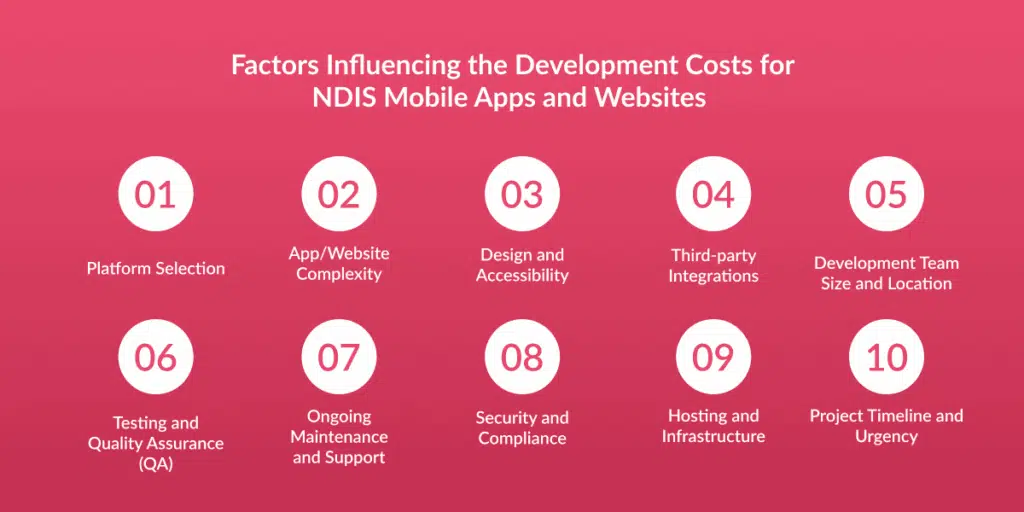
1. Platform Selection
The most crucial factor that affects the NDIS mobile app development costs is the platform you choose to build the app. If you develop a native app (separate apps for Android and iOS), it will cost you more, as the mobile app developers need to build them separately.
However, if you develop a cross-platform NDIS mobile app using frameworks like Flutter or React Native, you build a single codebase for both platforms, reducing the overall costs.
Similarly, for the NDIS website development, if you use custom frameworks to build the website, it will be going to cost you more. To cut down the costs, you can refer to standard CMS platforms, such as WordPress, to develop your dedicated NDIS website.
2. App/Website Complexity
As discussed in the earlier sections, if you develop a basic mobile app or a website for the NDIS, it will cost less, and the costs will surge as you move from an advanced to a complex version.
The reason behind this is that the basic platforms include features like user login and service booking.
More advanced solutions require more modules for staff management, real-time chat, invoice generation, and participant progress tracking, and the complex versions even include cutting-edge technologies like artificial intelligence, machine learning, and generative AI.
Building advanced and complex mobile apps and websites requires more development hours, which directly increases the project budget.
3. Design and Accessibility
NDIS apps and websites must be accessible to users with disabilities, requiring compliance with WCAG standards.
This means incorporating features like screen reader compatibility, high-contrast design, text resizing, and simple navigation. When developers design these features, they put in extra hours and effort to enhance usability for diverse users.
As a result, this significantly adds to the cost due to additional planning, testing, and implementation.
4. Third-party Integrations
Another factor that influences the building costs for NDIS mobile apps and websites is the third-party integrations.
When building websites and mobile apps for NDIS services, you need to integrate external tools and systems like NDIS payment gateways, CRMs, scheduling tools, or telehealth platforms, which adds technical complexity.
Each integration requires API work, testing, and maintenance, which can increase both the development timeline and overall cost. The more integrations required, the more resources are needed, and the more costly the development will be.
5. Development Team Size and Location
The size of your development team and their geographical location also add to the development costs.
For example, if your development team has a total of 6 members, including a project manager, mobile app developers, and testers, it will cost you less compared to the team having 8-10 members.
Similarly, the location of the development team also influences the development costs. For example, developers in Australia charge significantly more, somewhere between AUD 25/hour to AUD 40/hour. In contrast, mobile app developers in India or other similar countries charge around AUD 15/hour to AUD 25/hour.
You can clearly see the difference between the charges, hence, the location of the development team also influences the overall development costs.
So, these are the major factors that affect the development costs for NDIS apps and websites. Now, let’s explore the other miscellaneous factors that might add to your development costs, based on your project type.
Other (Miscellaneous) Factors
6. Testing and Quality Assurance (QA)
Comprehensive testing is crucial for ensuring a smooth, bug-free experience, especially for users with disabilities.
Thus, you need to conduct rigorous testing, such as functional testing, performance testing, security checks, and accessibility audits, before your app or website goes live.
All these testing processes require time and specialized tools, hence, they add to the overall development costs.
7. Ongoing Maintenance and Support
To keep your NDIS mobile app and website relevant for a long time, you need to monitor their performance frequently and upgrade them at frequent intervals.
So, to achieve this, you need to budget around 15–20% of the initial development cost annually for the ongoing maintenance and technical support.
This adds extra costs to the final NDIS mobile app and website development costs.
8. Security and Compliance
NDIS apps and websites must comply with data privacy regulations like the Australian Privacy Principles (APPs).
You need to integrate secure user authentication, encrypted data storage, and safe payment processing in your mobile app and website for the NDIS services.
Thus, ensuring a robust security infrastructure adds to the backend development cost but is essential for trust and legal compliance.
9. Hosting and Infrastructure
Reliable hosting and infrastructure are critical for performance, scalability, and uptime. Cloud services like AWS, Google Cloud, or Azure offer flexibility but come with recurring costs.
Therefore, it becomes important that you also need to consider expenses for SSL certificates, data backups, server management, and domain renewals, which add to the total cost.
10. Project Timeline and Urgency
Last but most important, the project timeline is also a miscellaneous expense that may increase your overall NDIS website and mobile app development costs.
If you require your app or website to be developed within a short timeframe, you may need to hire a larger team or pay for overtime, which increases costs.
Accelerated timelines often lead to parallel development processes and expedited testing, both of which demand more resources and project management, adding more costs to the final development costs.
Conclusion
With the growing demand for accessible, efficient, and user-centric NDIS mobile apps and websites, today is the right time to invest in custom mobile app or website development for the NDIS services.
With a tailored digital platform, it will be easy for you to streamline your operations, enhance participant engagement, and stay compliant with NDIS standards.
In this blog, we have given you an idea of how much it would cost to develop an NDIS mobile app or a website. The cost of building a basic NDIS mobile app can range from AUD 25,000 to 40,000, or more. The basic NDIS website development costs between AUD 10,000 to 20,000 or more.
Similarly, advanced NDIS mobile app development costs lie between AUD 40,000 to AUD 65,000, or more, and the advanced website can cost between AUD 30,000 to AUD 50,000, or more.
For the complex NDIS mobile app, you can expect the development costs to be up to AUD 70,000 to over AUD 90,000, or more, and for the complex NDIS website, the costs can be between AUD 60,000 to over AUD 80,000 or more.
We hope this will help you make informed NDIS mobile app and website development decisions.
How Developer Bazaar Technologies Can Help You!
Also, choosing the right development partner, like Developer Bazaar Technologies, can help you develop your mobile app and website at the lowest costs possible, without compromising quality.
We are the top mobile app development company with 8+ years of experience in developing NDIS-tailored mobile apps and websites for leading service providers in Australia.
By partnering with us, you can develop a digital platform that doesn’t just improve internal efficiency but also elevates the quality of care and services offered. So, what are you waiting for? Contact us today and get your NDIS app and website development started.
Frequently Asked Questions
Q1. What is NDIS?
The NDIS (National Disability Insurance Scheme) is an initiative of the Australian government that focuses on providing funding and support to people with disabilities. With this funding, the latter can access essential services, helping them to live more independently.
Q2. Why is developing an app or website for NDIS important?
Developing an NDIS mobile app and website can help NDIS service providers improve accessibility of the services, streamline their daily operations, offer real-time support to the participants, and ensure NDIS compliance.
Q3. How much does it cost to develop an NDIS mobile app and website?
The cost to develop an NDIS mobile app and website starts from AUD 10,000 and goes up to AUD 90,000+, depending on factors like complexity, features, development team, security, and more.
Q4. How long will it take to develop a website and mobile app for NDIS services?
Development timelines for NDIS mobile apps and websites usually range from 3 to 6 months, depending on project scope, features, and testing requirements. Also, complex platforms with custom integrations may even take longer.
Q5. How can I start developing an NDIS mobile app and website?
Start by defining your goals, features, and budget. Then, consult with us, Developer Bazaar Technologies, a trusted mobile app and website development company experienced in NDIS and accessibility standards, to plan, design, and build your platform.

RM Mishra
Co-Founder
Developer Bazaar technologies
